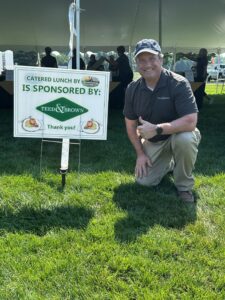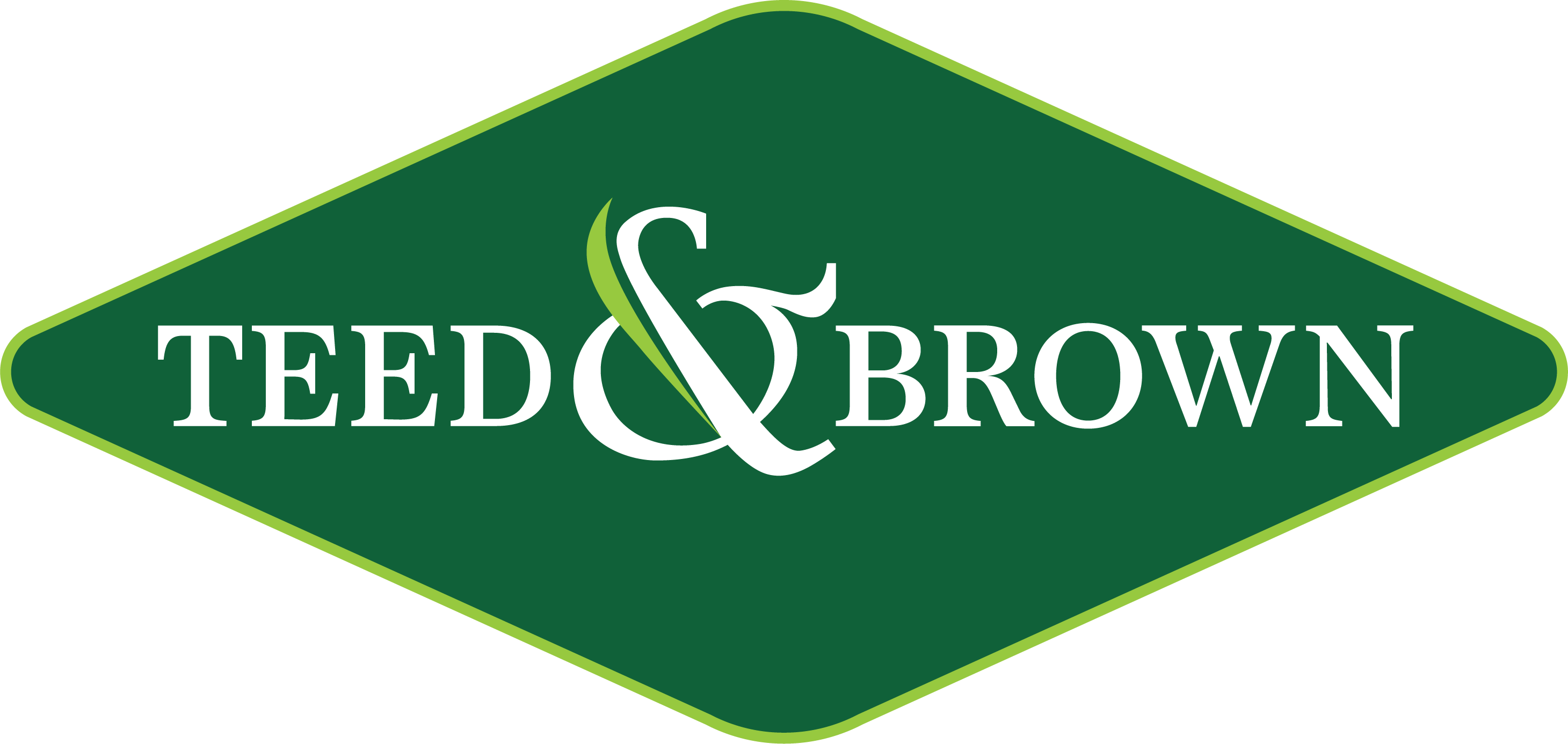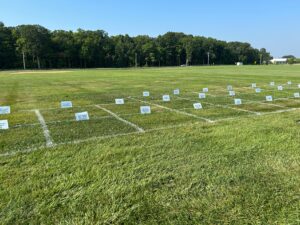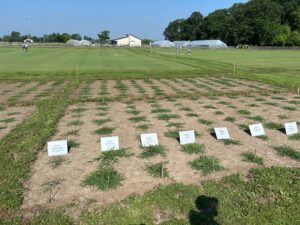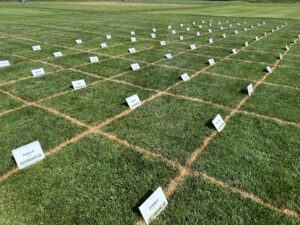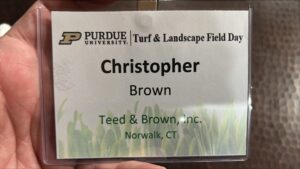Science-Backed Lawn Care Tips from Purdue
About Science-Backed Lawn Care Tips from Purdue
Field Notes from Purdue: What I Learned at the Turfgrass Field Days in West Lafayette
By Christopher Brown (CEO)
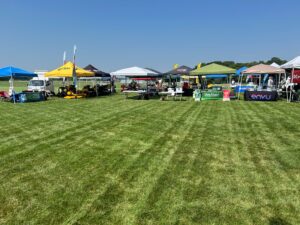
I had the chance to attend the Purdue Turfgrass Field Days in West Lafayette, Indiana, and it was both informative and refreshing—starting with check-in and, of course, a couple of complimentary donuts (the unofficial breakfast of lawn care professionals). The event was thoughtfully organized by specialty: golf course management, landscaping, sports turf, and lawn care. Naturally, I followed the lawn care track.
I was joined by an old friend, Julio Canto, who now runs his own lawn care business in a nearby area, focusing primarily on organic approaches. Joining us as well was Spencer Brown, Teed & Brown’s staff accountant—and my son—who’s recently taken an interest in the science behind lawn maintenance. It was a proud moment watching Spencer engage with the material, and great to compare perspectives with Julio, whose organic-first mindset brought a thoughtful angle to many of the topics we covered.

A Clover Comeback? Maybe.
Our day began with a talk from Brandon McNally on crabgrass control. His presentation challenged the assumptions of many in the audience—but it also reinforced something we’ve been saying for years: lawn length matters, a lot. Brandon’s research focused on incorporating microclover into turfgrass mixes, which produced impressive results. The presence of clover helped suppress crabgrass nearly as well as traditional pre-emergent herbicides. And with new varieties of microclover bred to spread more uniformly, the old issue of patchy, uneven lawns is becoming less of a concern.
He also showed compelling data on the relationship between mowing height and crabgrass prevalence. Simply put: the longer the grass, the less crabgrass. Even in untreated plots, taller mowing heights dramatically reduced crabgrass pressure, which drives home how powerful this one basic practice can be in maintaining lawn health.
That said, the clover approach isn’t without trade-offs. Some homeowners simply don’t like the look of clover. To them, it may feel like replacing one weed with another. But it’s important to consider how these plants behave. Crabgrass takes over aggressively in the summer, only to die completely at the first frost—leaving behind large, brown, unsightly patches. Clover, in contrast, remains green and stable throughout the year. So if the sight of clover doesn’t bother you, it’s a powerful, low-input alternative. If it does? Best to stick with more conventional strategies.
Creeping Charlie, Meet Iron and Boron
Next, we visited a research plot led by Dr. Aaron Patton, focused on ground ivy—commonly known as creeping Charlie. It’s one of those persistent weeds that refuses to go quietly. Despite the wide array of herbicides on the market, only two are consistently effective against it—and unfortunately, those two aren’t included in most of the popular blends used in residential lawn care. That helps explain why control is so often inconsistent.
Dr. Patton’s team also explored whether overdoses of micronutrients—specifically iron and boron—could offer an alternative control method. Iron had a modest effect but came with a hefty price tag and lower effectiveness. Boron showed promise but isn’t yet available commercially. The broader takeaway? Certain weeds are more sensitive to excessive levels of nutrients they normally need in small doses. But using that sensitivity in a practical, scalable way still needs work.
The Crabgrass Chronicles (Part Two)
Later in the day, we listened to Vera Vukovic, a PhD candidate specializing in turfgrass and horticulture. She took a deeper dive into crabgrass, highlighting the fact that it’s not just one weed but a family of species—including large crabgrass, smooth crabgrass, and others—some of which are developing resistance to common herbicides. Vera stressed the importance of rotating chemical treatments to avoid selecting for herbicide-resistant varieties.
Like Brandon’s presentation, Vera’s talk returned to the theme of mowing height, and once again the data was striking. Plots mowed at 4 inches had almost no crabgrass, even without pre-emergent treatment. At 3 inches, some crabgrass crept in. But at 2 inches or less, crabgrass exploded across the turf. That’s a visual and measurable reminder that simply mowing higher can make a dramatic difference in lawn health. It might be the single most underrated practice in residential lawn care.
Bluegrass, Fescue, and a Little Humor from Dr. Lee Miller
After Vera’s presentation, I had the chance to hear from Dr. Lee Miller on diseases that affect common home lawn grasses. His research focused primarily on Kentucky bluegrass and turf-type tall fescue—two of the most popular and widely respected varieties used in cool-season regions like ours.
Kentucky bluegrass, he explained, is highly susceptible to dollar spot disease but completely immune to brown patch. Turf-type tall fescue, on the other hand, is immune to dollar spot but vulnerable to brown patch. His research explored both disease management techniques for each variety and also investigated the idea of blending the two grasses within a single lawn. The concept is simple but smart: by mixing the two species, you’re building natural resilience. If one disease takes hold, the unaffected variety should survive and carry the appearance of the lawn through the outbreak, providing a more consistent, healthy look overall.
Dr. Miller lightened the mood with a joke at the expense of perennial ryegrass. When he asked if anyone in the crowd used it and a few hands went up, he smiled and said he likes to refer to it as “the quick and the dead.” It germinates fast—often within a week or two—but dies off just as quickly once environmental stress kicks in. And frankly, that tracks perfectly with our own real-world experience.
Many companies favor perennial ryegrass because it produces fast results—clients see green shoots in no time, and everyone’s happy. Until, of course, the ryegrass collapses later that season or the next, often under disease pressure or drought stress. We see it all the time when taking over new lawns that were seeded heavily with ryegrass by landscapers or other lawn companies. It often takes a couple of full seasons to correct the imbalance and establish a healthier lawn using Kentucky blue and tall fescue—both of which are slower to germinate but provide far greater durability and long-term success.
Iron: Not the Miracle We Hoped?
Our final stop of the day brought us to a presentation by Dr. Cale Bigelow, who shared results from his research into the visual and performance impact of iron on turfgrass. Iron is often marketed as a kind of “instant green-up” for turf, used to deepen color and enhance visual appeal.
But according to Dr. Bigelow’s trials, most of those benefits are modest—if not negligible. Across various plots, iron application produced only subtle changes, often too minor to notice in real-world lawn settings. There might be a small visual benefit under the right conditions, but it’s far from the dramatic transformation that some manufacturers suggest. In short: iron has its place, but it’s not a miracle cure. And for most homeowners and professionals, it may not justify the cost.
Why We Go
This trip to Purdue is just one of many we’ve made over the years with various members of our team. Whether it’s research stations, university field days, industry conferences, or continuing education events, we make these investments because they directly raise the bar for our company.
Staying on top of the latest research helps us fine-tune our programs, avoid dead-end solutions, and bring thoughtful, science-backed lawn care to our clients. But it’s more than that—it also keeps us sharp. Sharing these experiences as a team, learning together, and having conversations that challenge our assumptions helps push our collective knowledge forward. This isn’t just a job for us; it’s a craft. And days like this keep us improving it.
Final Thoughts
It was a full day of sun, science, and soil—made even better by sharing it with Julio and Spencer. The biggest takeaway? Sometimes the most effective strategies aren’t high-tech or high-cost. Whether it’s raising the mower deck, choosing the right seed, mixing in disease-resistant varieties, being skeptical of flashy quick fixes, or skipping the fast-germinating ryegrass that always lets you down, the smartest lawn care starts with the science. And that’s exactly why we keep showing up to events like these, year after year.
In need of lawn care services? Contact us today!
